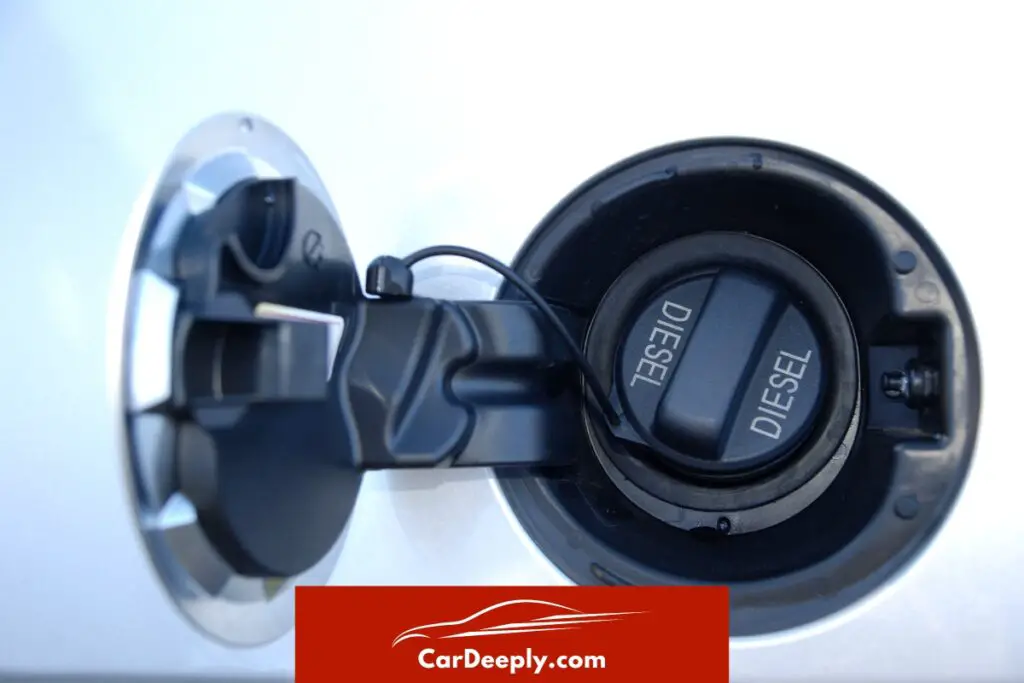The Ford F150 gas tank size is crucial for many truck enthusiasts and potential buyers. Over the years, understanding this feature has saved countless drivers from unexpected stops and refueling hassles.
In this article, you will find information on the evolution of the F150’s fuel capacity over different models, practical tips to maximize your truck’s mileage, and insights into how tank size impacts overall vehicle performance.
So, are you ready to fuel your curiosity? Let’s dive in!
Advertising links are marked with *. We receive a small commission on sales, nothing changes for you.
Key Takeaways

- Ford F150 gas tank sizes have evolved based on user needs and market trends.
- The 2021 F150 offers standard gas tank sizes of 23 or 26 gallons, with an optional 36-gallon tank.
- Factors like engine type, cab configuration, and model influence the gas tank size.
- Regular maintenance and mindful driving habits can enhance fuel efficiency.
- The F150’s fuel capacity is pivotal in driving range and refueling frequency.
Understanding the Ford F150 Gas Tank Size
Historical Overview of Ford F150 Gas Tank Sizes
The Ford F150, the flagship of American automotive engineering, has undergone numerous transformations since its inception.
The gas tank size is one of this evolution’s most overlooked yet vital components.
- Evolution over the years: In the early days, the F150 was equipped with a modest tank suitable for its time. As the years progressed, the demand for longer drives and more powerful engines necessitated larger tanks. This evolution wasn’t just a random change but a direct response to user needs and market trends.
- Factors influencing changes: Several elements played a role in this transformation:
- Engine type: The need for larger tanks became evident with the introduction of more fuel-efficient engines.
- Consumer demand: As road trips became popular, the need for trucks with larger fuel capacities grew.
- Technological advancements: Innovations in automotive design allowed for the integration of larger tanks without compromising vehicle aesthetics or performance.
Specifics of the 2021 Ford F150 Gas Tank Size
The 2021 Ford F150 stands out in the lineage, boasting impressive fuel capacities tailored to modern-day requirements.
- Standard sizes: Most models come equipped with a 23 or 26-gallon tank. These sizes are optimal for daily commuting and short trips.
- Optional 36-gallon tank: For those who crave extended adventures or have hefty towing needs, Ford offers specific configurations with a whopping 36-gallon tank. This option ensures fewer refueling stops and a more comprehensive range, ideal for long hauls.
Factors Determining the Gas Tank Size
Diving deeper, it’s evident that the gas tank size isn’t a mere number. It’s a carefully calculated component influenced by various truck specifications.
- Engine type: Whether you opt for a V6 or a V8, the engine’s fuel consumption rate plays a pivotal role in determining the tank size. More powerful engines often require larger tanks to maintain a comparable driving range.
- Cab and box configuration: The design and space allocation in different F150 models influence the tank’s size. For instance, a SuperCrew model might have a different fuel capacity than a Regular Cab.
- Model and trim level: The luxury trims, equipped with additional features, might have varied fuel capacities to cater to the added weight and power requirements.
Incorporating these insights into your understanding of the Ford F150’s fuel capacity ensures you’re well-equipped to make informed decisions, whether you’re a potential buyer or a curious enthusiast.
The blend of historical context, specifics of the latest models, and the factors influencing these decisions paint a comprehensive picture of the Ford F150 gas tank size.
Practical Insights and Tips
How to Determine Your F150’s Gas Tank Size
Identifying the exact gas tank size of your Ford F150 can be a game-changer, especially when planning long trips or managing fuel budgets. Here’s a step-by-step guide to help you pinpoint that crucial number:
- Check the Owner’s Manual: Your truck’s manual isn’t just a thick booklet gathering dust in the glove compartment. It’s a treasure trove of information. Navigate to the specifications section to find details about your truck’s fuel capacity.
- Measure the Gas Tank: If you’re feeling hands-on, this method is for you.
- Empty the tank (ensure you’re in a safe location).
- Refill it and note the gallons it takes to become full.
- Drive Until Empty and Refill: A more adventurous approach involves driving your truck until the fuel light comes on. Then, fill it up and note the amount of fuel it takes. This method might not be the most accurate due to reserve fuel.
Fuel Economy and Driving Range
Fuel economy isn’t just about saving money; it’s about maximizing the potential of every drop of gasoline.
- Average Miles Per Gallon: Modern Ford F150 trucks can range between 20 to 26 miles per gallon, depending on the engine type and driving conditions. This efficiency ensures you get the most out of your fuel.
- Estimated Distance on a Full Tank: With the knowledge of your tank size and average miles per gallon, you can easily calculate the estimated range. For a 26-gallon tank with an average of 23 miles per gallon, you’re looking at a whopping 598 miles!
- Factors Affecting Fuel Economy: Several elements can influence your truck’s fuel consumption:
- Driving Habits: Rapid acceleration and braking can reduce fuel efficiency.
- Tire Pressure: Ensure your tires are always inflated to the recommended PSI.
- Load: Carrying heavy loads or towing can impact fuel consumption.
Tips to Save on Fuel Costs with Your F150
Your Ford F150 is a powerhouse, but you can make every gallon count with a few tricks.
- Maintenance Routines: Regular oil changes, air filter replacements, and spark plug checks can boost fuel efficiency.
- Driving Habits: Smooth acceleration and braking, combined with maintaining a steady speed, can work wonders.
- Avoid Idling: If you’re stopping for over a minute, turn off the engine. Extended idling can consume more fuel than restarting the engine.
If you find yourself with a low fuel warning sign, don’t worry, there are many things you can do:
- Stay calm: Panicking won’t help. Stay calm and focused.
- Find a gas station: Use your car’s navigation system or a mobile app to find the nearest gas station.
- Drive conservatively: Avoid fast acceleration and high speeds to conserve fuel.
Ensuring the Longevity of Your Ford F150
Your truck is an investment; with some care, it can serve you for years.
- Regular Maintenance: Adhering to the service schedule ensures optimal performance and fuel efficiency.
- Proper Loading and Towing: Overloading or improper towing can strain the engine and reduce lifespan.
- Cleanliness and Care: Regular cleaning, both interior and exterior, not only keeps your truck looking pristine but also prevents rust and wear.
These insights and tips allow you to maximize your Ford F150’s fuel capacity, ensuring efficient drives and prolonged vehicle life.
Whether you’re a seasoned trucker or a newbie, understanding these nuances can elevate your driving experience. So, ready to hit the road with newfound knowledge?
Safe travels!
Frequently Asked Questions
How does the Ford F150’s gas tank size compare to other trucks in its class?
While the Ford F150 offers a range of gas tank sizes, including 23, 26, and 36 gallons, other trucks in its class might have different capacities. It’s essential to compare specific models and trims to get an accurate comparison.
However, the F150’s optional 36-gallon tank is one of the largest in the light-duty truck segment.
Can I modify my Ford F150 to have a larger gas tank?
Yes, aftermarket modifications are available to increase the gas tank size of your Ford F150. However, it’s crucial to ensure that any changes adhere to safety standards and don’t affect the vehicle’s warranty or performance.
How often should I check my Ford F150’s fuel efficiency?
It’s a good practice to monitor your truck’s fuel efficiency regularly, especially after maintenance or when changing driving conditions. Tracking miles per gallon every few fill-ups can provide insights into the vehicle’s performance and any potential issues.
Are there any apps or tools to help monitor my Ford F150’s fuel consumption?
Several apps and tools can help drivers monitor their vehicle’s fuel consumption, set reminders for maintenance, and even find the nearest gas stations. Popular options include Fuelly, GasBuddy, and the FordPass app.
How does driving in different terrains affect the Ford F150’s fuel consumpt
Driving in varied landscapes, such as hilly areas, off-road, or city traffic, can impact the Ford F150’s fuel consumption. Hilly terrains and off-road conditions might increase fuel usage, while smooth highway drives can enhance fuel efficiency.

Luna Meschiari is a full-blooded car nut who is well known to local garages, as each article is meticulously researched and peppered with the latest piece of information. Guess what car she’s driving right now? A RAV4 2021 Hybrid. But her heart also sleeps for pickups like the F-150. Get to know Luna better on the about us page.
Advertising links are marked with *. We receive a small commission on sales, nothing changes for you.
